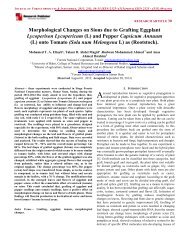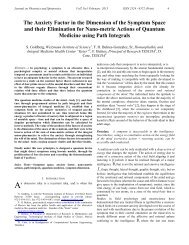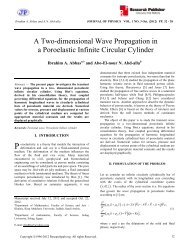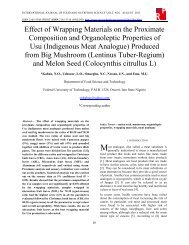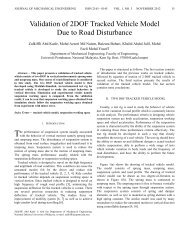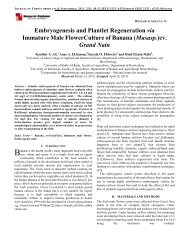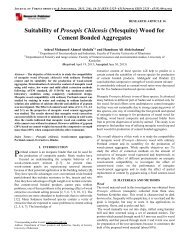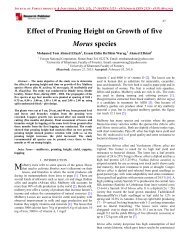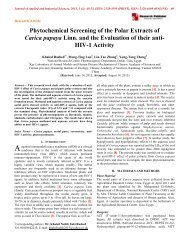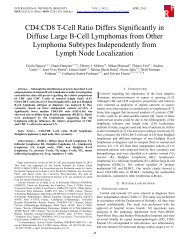INTERNATIONAL TRENDS IN IMMUNITY VOL.1 NO.2 APRIL 2013ISSN 2326-3121 (Print) ISSN 2326-313X (Online) http://www.researchpub.org/journal/iti/iti.htmlII. ESTROGEN RECEPTORS IN IMMUNE CELLSIntracellular ERs are expressed in all immune celltypes [14, 15]. Particularly, our group has recentlydem<strong>on</strong>strated <strong>the</strong> intracellular expressi<strong>on</strong> of bothERα <strong>and</strong> ERβ in T, B lymphocyte subsets, <strong>and</strong>peripheral NK cells [16]. The ERα46 isoformappeared to be <strong>the</strong> most represented ER inlymphocytes without significant differences am<strong>on</strong>glymphocyte subsets. Although ERβ was expressed inall lymphocyte subsets, our data suggest a lowerexpressi<strong>on</strong> level of this receptor with respect toERα46.The typical physiological level of E2 is extremelylow, in <strong>the</strong> range of 10–900 pg/ml, <strong>and</strong> it varies based<strong>on</strong> <strong>the</strong> age <strong>and</strong> physiological status of <strong>the</strong> individual(i.e., E2 levels are typically less than 100 pg/ml, butjust before ovulati<strong>on</strong> <strong>the</strong>y spike to 800 pg/ml, <strong>and</strong>during <strong>the</strong> third trimester of pregnancy vary from 0.5to 140 ng/ml) [17]. E2 can produce different effectsdepending <strong>on</strong> its c<strong>on</strong>centrati<strong>on</strong> but also <strong>on</strong> <strong>the</strong> type oftarget cell, <strong>the</strong> receptor subtype present <strong>on</strong> a givencell type, <strong>and</strong> <strong>the</strong> timing of administrati<strong>on</strong>. Table Isummarizes <strong>the</strong> most important effects of high <strong>and</strong>low c<strong>on</strong>centrati<strong>on</strong>s of E2 <strong>on</strong> different types ofimmune cells. In brief, at pregnancy levels, E2inhibits pro-inflammatory pathways such as TNFα,IL-1β, IL-6, <strong>and</strong> activity of natural killer (NK) cells,whereas E2 at <strong>the</strong> same c<strong>on</strong>centrati<strong>on</strong> stimulatesanti-inflammatory pathways such as IL-4, IL-10, <strong>and</strong>TGFβ [2]. Additi<strong>on</strong>ally, it enhances <strong>the</strong> number <strong>and</strong>functi<strong>on</strong> of CD4+CD25+ regulatory T cells [18, 19].Surprisingly, no direct effect of E2 <strong>on</strong> Th17 cells orIL-17 producti<strong>on</strong> has been described in humans untilnow, whereas c<strong>on</strong>flicting results have been reportedin animal models where E2, at high c<strong>on</strong>centrati<strong>on</strong>s,ei<strong>the</strong>r enhances [20] or decreases [21] IL-17producti<strong>on</strong>. At lower c<strong>on</strong>centrati<strong>on</strong>s, E2 stimulatesTNFα, IFN-γ, IL-1β, <strong>and</strong> activity of NK cells [2].Differently, E2 stimulates antibody producti<strong>on</strong> by Bcells throughout <strong>the</strong> c<strong>on</strong>centrati<strong>on</strong> range [2].Regarding cell surface expressi<strong>on</strong> of ERs <strong>on</strong> humanlymphocytes, previously reported data, obtainedusing E2 covalently bound to bovine serum albumin(BSA)-FITC, indicated that an estrogen bindingprotein exists <strong>on</strong> <strong>the</strong> plasma membrane of humanlymphoblastoid B cells [22]. More recently, by usingepitope-binding technologies, we dem<strong>on</strong>strated <strong>the</strong>cell surface expressi<strong>on</strong> of a functi<strong>on</strong>ally activeERα46 isoform, but not of ERβ, <strong>on</strong> lymphocytes,supporting <strong>the</strong> idea that E2 level fluctuati<strong>on</strong>s may beassociated with a prompt lymphocyte resp<strong>on</strong>se [16].In particular, E2-BSA significantly increased CD4+<strong>and</strong> CD8+ T lymphocyte proliferati<strong>on</strong> in resp<strong>on</strong>se toanti-CD3 m<strong>on</strong>ocl<strong>on</strong>al antibody <strong>and</strong> IFN-γ producti<strong>on</strong>by NK cells. Fur<strong>the</strong>r studies are needed to a betterdefiniti<strong>on</strong> of mER expressi<strong>on</strong> <strong>and</strong> its signaltransducti<strong>on</strong> pathway in different lymphocytesubpopulati<strong>on</strong>s. In this regard, <strong>the</strong> development of anovel transgenic mouse in which mER-signaling isblocked [23] may be helpful to elucidate how mERsignaling c<strong>on</strong>tributes to <strong>the</strong> transcripti<strong>on</strong>al functi<strong>on</strong>sof intracellular ERs <strong>and</strong> could lead to identify <strong>the</strong>rapid ER signaling pathway as a potential target fornovel <strong>the</strong>rapeutic agents.TABLE IESTROGEN EFFECTS ON IMMUNE CELLS↑, indicates stimulati<strong>on</strong> by E2, ↓ indicates inhibiti<strong>on</strong> by E2III. SYSTEMIC LUPUS ERYTHEMATOSUS (SLE)Sex horm<strong>on</strong>es, including estrogens, have beenproposed to play an important role in autoimmunity,[14, 24-26], although <strong>the</strong> precise mechanisms bywhich estrogens modulate <strong>the</strong> cellular <strong>and</strong> molecularprocesses that govern immune homeostasis are far tobe fully elucidated. A prototypic autoimmunedisease is SLE which is a multifactorial <strong>and</strong> highlypolymorphic systemic AD with a higher incidence inwomen than man [27]. Pre-menopausal women haveSLE incidence rates of 9:1 when compared toage-matched males [28]. These rates decline to 5:1after menopause. In <strong>the</strong> pre-adolescent populati<strong>on</strong>,where estrogen levels are more similar betweengenders, females have SLE with a frequency of 3:1when compared to males.25
INTERNATIONAL TRENDS IN IMMUNITY VOL.1 NO.2 APRIL 2013ISSN 2326-3121 (Print) ISSN 2326-313X (Online) http://www.researchpub.org/journal/iti/iti.htmlSLE affects multiple organs, including skin, muscle,joints, <strong>and</strong> vital internal organs, such as kidneys <strong>and</strong>heart. Despite <strong>the</strong> number of studies reported so far,<strong>the</strong> etiology of SLE remains unknown. However, it islikely that <strong>the</strong> complex interacti<strong>on</strong> between genetic,envir<strong>on</strong>mental (e.g., infectious agents, UV light,drugs), <strong>and</strong> horm<strong>on</strong>al factors promotes <strong>the</strong> immunedysfuncti<strong>on</strong> underlying <strong>the</strong> pathogenesis of <strong>the</strong>disease [29, 30]. SLE is characterized byautoantibody producti<strong>on</strong> by dysregulated B cells,target organ infiltrati<strong>on</strong> by inflammatory T cells, <strong>and</strong>aberrant immune cell activati<strong>on</strong> due to abnormalantigen presenting cell functi<strong>on</strong>. Theautoantigen-autoantibody interacti<strong>on</strong> triggers <strong>the</strong>formati<strong>on</strong> of immune complexes that, <strong>on</strong>ce deposited,cause tissue injury. In particular, immune complexes,c<strong>on</strong>taining autoantibodies against DNA <strong>and</strong>rib<strong>on</strong>ucleoproteins, activate Toll like receptors(TLR)7 <strong>and</strong> TLR9 <strong>on</strong> dendritic cells <strong>and</strong> B cells, <strong>and</strong>this event leads to enhanced autoantibody producti<strong>on</strong><strong>and</strong> IFN-α secreti<strong>on</strong>, which is suggested to be keymodulator in <strong>the</strong> pathogenesis of SLE [31].As stated above, <strong>the</strong> incidence of SLE increases afterpuberty <strong>and</strong> flares are more comm<strong>on</strong> during <strong>the</strong>pre-menstrual period <strong>and</strong> pregnancy, time frameswith increased estrogen levels. Additi<strong>on</strong>ally, <strong>the</strong>disease is more prevalent in some ethnic groups, suchas Afro-Americans <strong>and</strong> Asians. Interestingly,estrogen levels were shown to be higher in Asian(Japanese) <strong>and</strong> African (Bantu) women than inCaucasian women [32]. This evidence implies animportant role of estrogens in SLE pathogenesis but<strong>the</strong> mechanisms involved have not been fullyelucidated [33, 34].IV. ESTROGENS AND ERs IN SLEIn vitro studies revealed that lymphocytes from SLEpatients exhibit an increased sensitivity to E2 [33]. Asummary of in vitro effects of E2 <strong>on</strong> lymphocytesfrom SLE patients is reported in Table II. It isimportant to underline that all <strong>the</strong> studies describedbelow were performed with physiological E2c<strong>on</strong>centrati<strong>on</strong>s. E2 in vitro enhanced total IgGproducti<strong>on</strong> as well as anti-dsDNA autoantibodyproducti<strong>on</strong> in SLE patients by promoting B cellactivity <strong>and</strong> by increasing IL-10 producti<strong>on</strong> inm<strong>on</strong>ocytes [35]. Autoantibodies were not secreted byB lymphocytes from healthy d<strong>on</strong>ors treated in <strong>the</strong>same way [35]. Additi<strong>on</strong>ally, mRNA expressi<strong>on</strong> of<strong>the</strong> T cell activati<strong>on</strong> markers calcineurin <strong>and</strong> CD154were up-regulated by E2 in SLE but not in normal Tcells through both ERα <strong>and</strong> ERβ [36-39]. Calcineurin<strong>and</strong> CD154 mRNA expressi<strong>on</strong> was alsodown-regulated in SLE patients treated with <strong>the</strong> ERantag<strong>on</strong>ist Fulvestrant (Faslodex) in associati<strong>on</strong>which a reducti<strong>on</strong> of disease activity [40].Interestingly, although E2 induced ERKphosphorylati<strong>on</strong> in a wide variety of cell types, itsuppressed ERK activati<strong>on</strong> in activated T cells frompatients with inactive or mild disease but not frompatients with active disease [41]. Whe<strong>the</strong>rE2-dependent dampening of ERK signalling isimportant for maintaining inactive disease remains tobe elucidated. E2 was also found to inhibits apoptosisin activated T cells, this favouring <strong>the</strong> persistence ofautoreactive cl<strong>on</strong>es [42]. On <strong>the</strong> o<strong>the</strong>r h<strong>and</strong>, Rastin etal. [43] showed that E2 increased <strong>the</strong> mRNAexpressi<strong>on</strong> level of FasL <strong>and</strong> caspase-8 in resting Tlymphocytes.More recently, E2 has been found to alter differentsignaling pathways in SLE T cells, that areassociated with disease <strong>on</strong>set <strong>and</strong> progressi<strong>on</strong>,including IFN-α signaling [44]. A fur<strong>the</strong>r potentialmechanism of acti<strong>on</strong> of E2 in SLE pathogenesis hasbeen suggested by Young et al. [45] who found that<strong>the</strong> signaling <strong>and</strong> transcripti<strong>on</strong> molecule ZAS3,which is involved in regulating inflammatoryresp<strong>on</strong>ses, was overexpressed in peripheral bloodm<strong>on</strong><strong>on</strong>uclear cells (PBMC) from SLE patients <strong>and</strong> itwas up-regulated by E2. E2 inducti<strong>on</strong> of ZAS3requires ERα. Intriguingly, ZAS3 <strong>and</strong> E2 both targetNFκB <strong>and</strong> lead to its functi<strong>on</strong>al repressi<strong>on</strong>, just asobserved in SLE [46]. The expressi<strong>on</strong> of ER has beeninvestigated in T cells from SLE patients todetermine whe<strong>the</strong>r <strong>the</strong> hyper resp<strong>on</strong>siveness of SLElymphocytes to E2 could be ascribed to differences inER levels. No alterati<strong>on</strong>s in <strong>the</strong> expressi<strong>on</strong> of ERα orERβ (both at mRNA <strong>and</strong> protein levels) weredetected in SLE [39, 47, 48], although ERα proteinwas found to exhibit a greater degree of variati<strong>on</strong>than that in c<strong>on</strong>trol T cells [39].The c<strong>on</strong>tributi<strong>on</strong>s of microRNA (miRNA) topathogenesis of SLE are beginning to be uncovered[49]. miRNAs are short (19–24 nucleotides in length)n<strong>on</strong>-coding RNAs that regulate messenger RNA(mRNA) or protein levels ei<strong>the</strong>r by promotingmRNA degradati<strong>on</strong> or by attenuating proteintranslati<strong>on</strong>. Evidence suggests that estrogens may26



